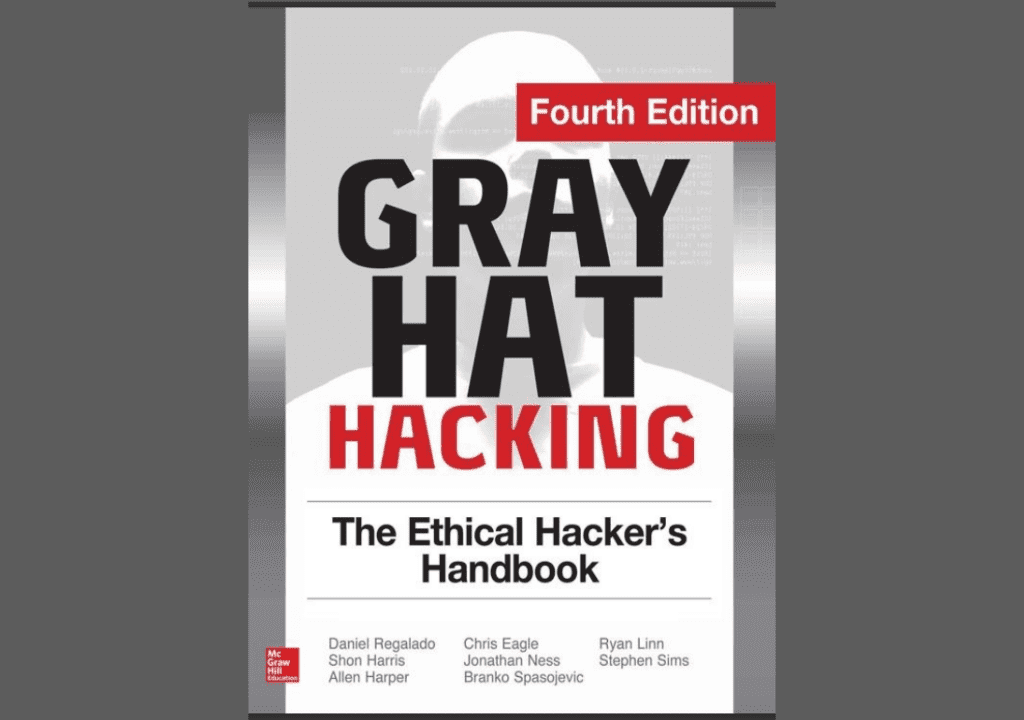
Gray Hat Hacking The Ethical Hackers Handbook
If you want to learn how to hack ethically and legally, you might want to check out Gray Hat Hacking The Ethical Hackers Handbook. This is a series of books that teach you how to do ethical hacking and penetration testing with practical and up-to-date advice. The books cover a lot of topics, such as network security, web application security, malware analysis, reverse engineering, mobile and IoT security, and more. The books also show you the tools, techniques, and tactics that malicious hackers use and how to protect yourself from them. The books are written by experts and researchers in the security field who share their insights and experiences through case studies, labs, and code examples.
Gray Hat Hacking The Ethical Hackers Handbook sixth edition:
The series has six editions so far. The newest one is the Gray Hat Hacking The Ethical Hackers Handbook sixth edition, which came out in March 2022. It has 13 new chapters that deal with the latest threats and vulnerabilities, such as Android-based exploits, ransomware, and cloud security. It also has updated content on old topics, such as programming survival skills, social engineering, web hacking, wireless hacking, and more. The book is based on the courses that the authors developed at big security conferences and colleges.
Gray Hat Hacking The Ethical Hackers Handbook fifth edition:
The older editions of the series are also online. The Gray Hat Hacking The Ethical Hackers Handbook fifth edition came out in April 2018 and had nine new chapters on topics like Windows 10 security, PowerShell attacks, hacking Bitcoin wallets, and more.
Gray Hat Hacking The Ethical Hackers Handbook fourth edition:
The Gray Hat Hacking The Ethical Hackers Handbook fourth edition came out in January 2015 and had eight new chapters on topics like hacking hardware, mobile devices, online games, and social networks.
Gray Hat Hacking The Ethical Hackers Handbook third edition:
The third edition came out in February 2011 and had seven new chapters on topics like web application scanners, exploiting Windows 7 vulnerabilities, hacking VoIP systems, and more.
Gray Hat Hacking The Ethical Hackers Handbook is a great resource for anyone who wants to learn how to hack ethically and legally. The books are for both beginners and advanced readers who want to improve their skills and knowledge in cybersecurity. The books are also helpful for security practitioners, researchers, educators, students, and enthusiasts who want to keep up with the latest trends and developments in the hacking world.
You can easily download the PDF of Gray Hat Hacking The Ethical Hackers Handbook Fourth Edition below.
PDF Book
Gray Hat Hacking The Ethical Hackers Handbook
Key Features of Gray Hat Hacking The Ethical Hackers Handbook Fourth edition
Some of the key features of Gray Hat Hacking The Ethical Hackers Handbook Fourth Edition are:
- It is a comprehensive guide on how to perform ethical hacking and penetration testing using cutting-edge techniques and tools.
- It covers various topics such as network security, web application security, malware analysis, reverse engineering, mobile and IoT security, and cyber law.
- It explains the tools, techniques, and tactics used by malicious hackers and how to defend against them.
- It is written by experienced security professionals and researchers who share their knowledge and expertise through case studies, labs, and code examples.
- It is based on the curricula developed by the authors at major security conferences and colleges.
- It contains 12 new chapters that cover the most recent threats and vulnerabilities, such as Android-based exploits, ransomware, and cloud security.
- It also includes updated content on existing topics, such as programming survival skills, social engineering, web hacking, wireless hacking, and more.
Other Books
Gray Hat Hacking The Ethical Hackers Handbook Free Download
C++ Primer 5th Edition PDF Free Download
Calculus 11e Textbook By Ron Larson & Bruce Edwards
The Science and Engineering Of Materials | Sixth Edition
An Introduction to Quantum Field Theory By Michael E. Peskin
What is Ethical Hacking
Ethical hacking, also known as white hat hacking or penetration testing, refers to the practice of intentionally probing computer systems, networks, or applications for security vulnerabilities and weaknesses. Ethical hackers are individuals or security professionals who conduct these activities with the permission and authorization of the system owner, organization, or entity.
The primary objectives of ethical hacking are:
- Identifying Vulnerabilities: Ethical hackers use their expertise to identify weaknesses in a system’s defenses. These vulnerabilities can include software flaws, misconfigurations, or insecure practices that could potentially be exploited by malicious hackers.
- Assessing Security: Ethical hackers assess the overall security posture of a system or network. They evaluate whether existing security measures are effective in protecting against unauthorized access, data breaches, or cyberattacks.
- Mitigating Risks: Once vulnerabilities are identified, ethical hackers work with the system owner to address and fix these issues. This proactive approach helps prevent potential cyber threats and data breaches.
- Enhancing Security Awareness: Ethical hacking also serves as a means to raise awareness about cybersecurity within an organization. It highlights the importance of regular security assessments and the need for ongoing vigilance against evolving threats.
Ethical hackers typically follow a strict code of ethics and adhere to legal guidelines when conducting their assessments. They obtain written consent from system owners, maintain confidentiality, and ensure that their actions do not cause harm or disruption beyond the scope of the agreed-upon testing.
By mimicking the tactics and techniques of malicious hackers, ethical hackers play a crucial role in strengthening cybersecurity and protecting sensitive data. Their work helps organizations stay ahead of potential cyber threats, safeguarding their systems and information from unauthorized access and cyberattacks.
White Gray and Black hat hacking
White Hat Hacking:
-
- White hat hacking refers to a form of hacking where individuals or security professionals use their expertise to identify and address vulnerabilities in computer systems, networks, or applications.
- These hackers are often hired by organizations to conduct authorized penetration testing or security audits.
- The term “white hat” signifies the ethical and legal nature of their activities. They work to strengthen security and protect against malicious attacks.
Gray Hat Hacking:
-
- Gray hat hacking represents a middle-ground approach where individuals or hackers may uncover vulnerabilities without explicit authorization, but their intentions are not malicious.
- These hackers may inform the affected parties about the vulnerabilities but may not always follow legal procedures or obtain permission before testing systems.
- The ethical and legal aspects of gray hat hacking can be ambiguous, as their actions may fall into a gray area between ethical and unethical behavior.
Black Hat Hacking:
-
- Black hat hacking involves malicious activities where hackers exploit vulnerabilities in computer systems, networks, or software for personal gain, financial profit, or malicious intent.
- These hackers engage in illegal activities such as stealing data, spreading malware, conducting cyberattacks, and other criminal actions.
- The term “black hat” is associated with the malicious and illegal nature of their actions, as they operate outside the boundaries of the law and ethical standards.
In summary, white hat hackers are ethical cybersecurity experts who work to improve security, gray hat hackers operate in a morally ambiguous space between legality and ethics, and black hat hackers engage in malicious and illegal activities for personal gain or malicious purposes. The choice of “hat” reflects the ethical stance and intentions of hackers in the cybersecurity field.
Hack Meaning in Urdu
The Urdu word for “hack” is not very common or accurate. It is “اجرتی” (ajarti). But most people use “ہیک” (haik) instead. This is also a noun that means a notch, a cut, a hacking, a catch in speaking, or a short, broken cough. Another word that can mean “hack” is “پاش پاش کرنا” (paash paash karna). This is a verb that means to cut without skill or purpose, to notch, or to mangle with a cutting tool. The word “hack” can also mean different things in different situations. For example, it can mean a horse that is old or rented, a coach or carriage that is for hire, a bookmaker who does any kind of literary work, a drudge, or a procuress. Also, the word “hack” can mean something related to computers. It can mean a smart computer program that does something in a hidden way, a fast and ugly but working solution to a programming problem, to program a computer for fun or obsession, or to try to break into a computer’s security. These meanings are from the field of cybersecurity and hacking, and they may not have exact words in Urdu. So they are usually written as “ہیک” (haik) or “ہیکنگ” (hacking) in Urdu.
